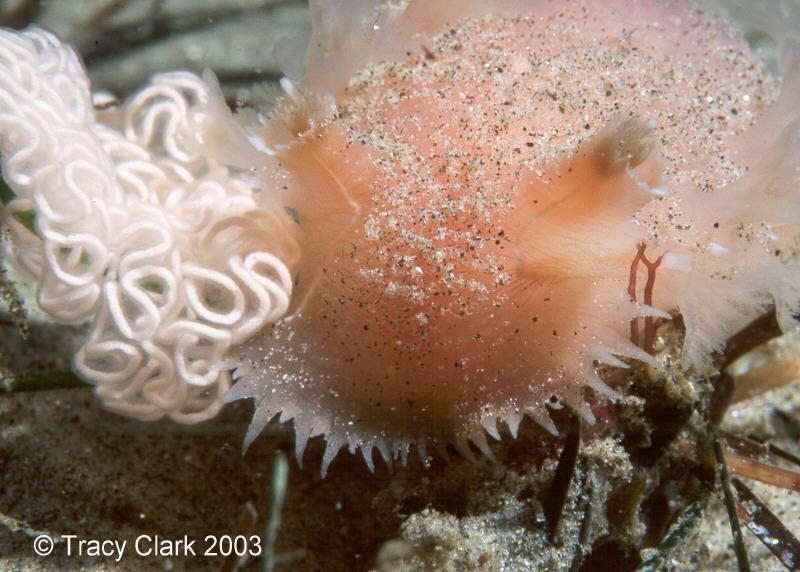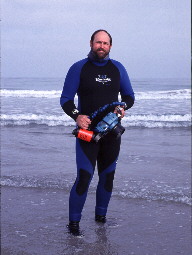 |
Tritonia diomedea
Photo courtesy of Tracy Clark
Tritonia diomedea Bergh 1894
A lot of research has been done on Tritonia diomedea since it was "nudi- of the week" #76 . This large nudibranch is studied by a small cohort of laboratories scattered around the US. All of these investigators are "descended" from the founder of Tritonia neurobiology AO Dennis Willows, at the Friday Harbor Laboratories. Many of us return to Friday Harbor to do research during the summer or on sabbaticals. There is a large diversity of opisthobranchs around the San Juan archipelago, and the diving is excellent. Although currents around the islands can reach a few meters per second, wave action is almost absent.
Tritonia has adapted to the high tidal flow by evolving an ability to reduce its hydrodynamic drag by orienting head-first into flow, flattening its body, and using its oral veil to push a berm of sand in front. This orientation to flow also seems to function in finding the source of chemical signals from prey (sea pens in the Washington and British Columbia), and of potential mates. Tritonia, like most slugs is a hermaphrodite, and is eager to mate with any conspecific it encounters (Russell Wyeth). They navigate blindly by feeling with the oral veil, and sensing tidal flow and the geomagnetic field (Ken Lohmann, AOD Willows). This magnetic orientation seems to function to help the Tritonia remember which way shore is located.
My research focuses on the neural mechanisms of how they orient to tidal flow. Tritonia is ideal for neurophysiological research into behavior because of its large, brightly colored brain cells. We have taken advantage of the large cells to inject drugs that inactivate single brain cells to determine what each cell does. Our research indicates that only a few neurons control each behavior, like crawling and escape swimming.
Tritonia is used as a model system for the neural basis of hallucinations (Bill Frost), and Willows lab is developing an implantable electrode that allows one to record from single cells in intact slugs after returning them to their natural habitat. Others have investigated the neurotransmitters and neural circuitry involved in crawling and swimming. They have identified a new peptide hormone, and are investigating the role of the neurotransmitter in arousal.
Below is the most recent published research on Tritonia diomedea .
Reference List
1. Beck, J. C., Cooper, M. S., and Willows, A. O. Immunocytochemical localization of pedal peptide in the central nervous system of the gastropod mollusc Tritonia diomedea. J Comp Neurol 425(1), 1-9. 2000.
2. Beck JC, Murray JA, Willows AOD, and Cooper MS Computer-assisted visualization of neural networks: expanding the field of view using seamless confocal montaging. J Neurosci Methods 98: 155-163, 2000.
3. Clemens, S. and Katz, P. S. Identified serotonergic neurons in the Tritonia swim CPG activate both ionotropic and metabotropic receptors. J Neurophysiol 85(1), 476-9. 2001.
4. Clemens, Stefan and Katz, Paul S. G Protein Signaling in a Neuronal Network is Necessary for Rhythmic Motor Pattern Production. J Neurophysiol 89(2), 762. 2003.
5. Clemens, Stefan and Katz, Paul S. Identified Serotonergic Neurons in the Tritonia Swim CPG Activate Both Ionotropic and Metabotropic Receptors. J Neurophysiol 85(1), 476. 2001.
6. Croll, R. P., Boudko, D. Y., and Hadfield, M. G. Histochemical survey of transmitters in the central ganglia of the gastropod mollusc Phestilla sibogae. Cell Tissue Res 305(3), 417-32. 2001.
7. Fickbohm, D. J. and Katz, P. S. Paradoxical actions of the serotonin precursor 5-hydroxytryptophan on the activity of identified serotonergic neurons in a simple motor circuit. J Neurosci 20(4), 1622-34. 2000.
8. Fickbohm, D. J., Lynn-Bullock, C. P., Spitzer, N., Caldwell, H. K., and Katz, P. S. Localization and quantification of 5-hydroxytryptophan and serotonin in the central nervous systems of Tritonia and Aplysia. J Comp Neurol 437(1), 91-105. 2001.
9. Mongeluzi, D. L. and Frost, W. N. Dishabituation of the Tritonia escape swim. Learn Mem 7(1), 43-47. 2000.
10. Popescu, I. R. and Frost, W. N. Highly dissimilar behaviors mediated by a multifunctional network in the marine mollusk Tritonia diomedea. J Neurosci 22(5), 1985-93. 2002.
11. Wang, J. H., Cain, S. D., and Lohmann, K. J. Identification of magnetically responsive neurons in the marine mollusc Tritonia diomedea. J Exp Biol 206(Pt 2), 381-8. 2003.
12. Willows, A. O., Nikitina, L. A., Bezuglov, V. V., Gretskaia, N. M., and Buznikov, G. A. [The possible functional interaction of serotonin and neuropeptides in embryogenic regulatory processes (experiments on embryos of the mollusk Tritona diomedea)]. Ontogenez 31(2), 132-8. 2000.
Conway, Arkansas
Jul. 2003

| Asst. Prof., Department of Biology 156 Lewis Science Center University of Central Arkansas Conway, AR 72035 PH: 501-450-5923 FAX: 501-450-5914 EMAIL: tritoniadiomedea@mac.com or visit Jim's Homepage |

Picture was taken with a Nikon N90, Subal housing, two YS-90 strobes. You will find Tracy at La Jolla Shores almost every weekend.
Send Tracy mail at tdclark@adnc.com |
